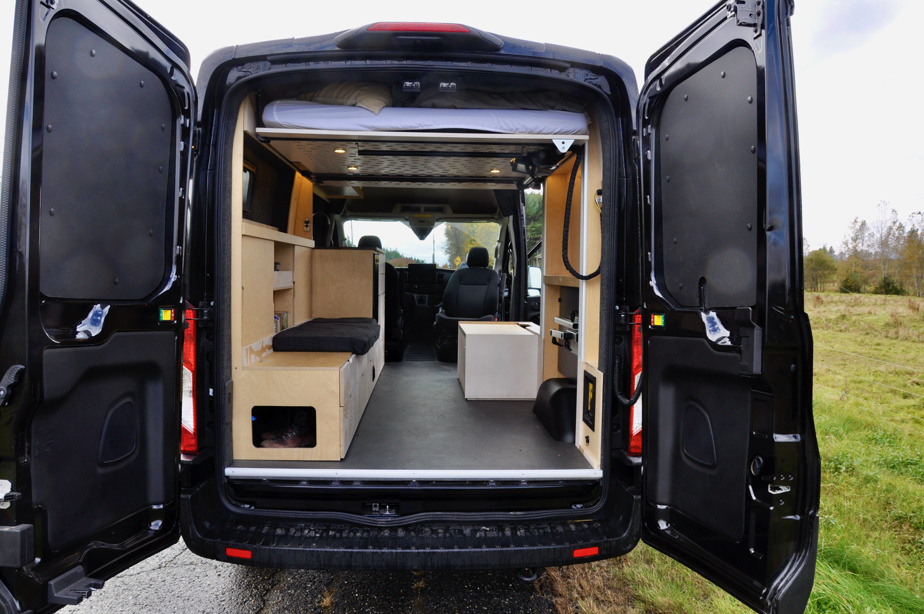Driving a recreational vehicle without burning gas is the dream of more and more outdoor enthusiasts. This fantasy now appears possible thanks to the Bromont Campervan company. Starting next summer, it will be renting a Ford E-Transit converted into a fully electric motorhome. The Press tried it first.
Posted yesterday at 11:45 a.m.
Three small numbers, displayed under the word “autonomy” on the dashboard, quickly make us realize that we are not on board a combustion engine vehicle. This number will never exceed 198 kilometers (in ideal weather conditions), even with fully charged batteries.
In short, we might as well admit it from the start, this motorhome is not made for lovers of road trips. During our test, conducted during a cold autumn weekend, it took 35 minutes for a 100 KW charging station to bring our load needle up from 41% to 85%. How far had we traveled since our previous charge, still at 85%? Barely 100 kilometers.
The use of the heating system has certainly eroded part of the autonomy, but the air conditioning in the heat of July will probably do the same.

PHOTO ANDRÉ LAROCHE, SPECIAL COLLABORATION
With this Ford E-Transit (electric), you have to calculate your distances well so as not to break down.
Slow tourism
At first glance, this handicap may seem like a major pitfall. It forces the traveler to better plan his journeys, first of all so as not to break down, but also to reconcile these obligatory stops with his meal breaks and his tourist interests. Time is precious, even (especially?) on vacation.
This is why this motorhome will appeal more to fans of so-called “slow” tourism. Quebecers have had a foretaste, in times of pandemic, of this way of traveling: instead of spending their vacations driving over long distances, the “slow tourist” will opt for the discovery of a chosen region, from an artisan boutique to a gourmet table, via a museum, a microbrewery or a water park.
It is not insignificant, moreover, that most of the time we find charging stations in these places.
All the precautions did not protect us from mid-term stops. But for the slow tourist, these unexpected stops (“Look! There’s a terminal there!”) can also turn into so many opportunities to be seized.
Thus, in our little journey, we took an unexpected walk in the charming village of Ayer’s Cliff. And the next day, in front of the rainy weather, hop! we set up the table and took out the board games.

PHOTO ANDRÉ LAROCHE, SPECIAL COLLABORATION
The stops imposed by the Ford E-Transit (electric) allow you to make discoveries.
Utility layout
With this in mind, the layout of the Bromont Campervan motorhome, imagined by the preparer EazyVans of Cowansville, can be perplexing in some respects.
The absence of real seats, the metal of the rear doors, the low ceiling and the scarcity of natural light made us feel, on a cold day, really confined to the back of a utility truck. Difficult, under these conditions, to indulge in relaxation and languor. Even the position of the table, shifted in relation to the benches, does not encourage head-to-head meetings.
On the other hand, the Spartan comfort and the large cargo space will delight anyone who likes to lug around bikes and other toys for fun outside. The rubberized floors, durable and easily washable, are also made to receive sand, mud and other traces of outdoor pleasures.

PHOTO ANDRÉ LAROCHE, SPECIAL COLLABORATION
The absence of real seats, the metal of the rear doors, the low ceiling and the scarcity of natural light are some disadvantages of this Ford E-Transit (electric).
Kitchenette and removable bed
The vehicle is equipped with a kitchenette complete with fridge, retractable table, sink and running water, as well as an induction hot plate. A chemical toilet is well concealed in a drawer. The pretty varnished wood finish, embellished with foliage motifs, is a wise choice, in keeping with the green virtues of an electric van.
All electrical accessories are powered by a powerful auxiliary battery, which in no way affects the autonomy of the caravan.
At the rear is a removable double bed that can be raised to the ceiling in the morning at the press of a button. This gives better access to ingenious compartments, well distributed along the walls, which allow efficient organization of equipment. A remote control locks all the drawers at once to ensure they don’t open at the first turn.

PHOTO ANDRÉ LAROCHE, SPECIAL COLLABORATION
The interior of the Ford E-Transit
The ride and comfort aren’t that different from a gas-powered vehicle. Road holding, acceleration and noise level did not disorient us in any way. He was just curious to engage the forward, reverse and neutral gears with a button similar to a ventilation selector.
And consumption, in all this? Traveling 417 kilometers in three days, at an average speed of 95 km/h, on the highway and secondary roads of the Eastern Townships, cost us a total of $45.16. Even better, we ended the journey with a calmer environmental conscience and a desire to start over.
Appreciation
WE love
- The absence of exhaust gases
- Driving pleasure
- The removable bed
- Ingenious storage
We love less
- No connection to an outside tap
- The absence of an independent heat pump
- The low ceiling
- The scarcity of natural light at the back
